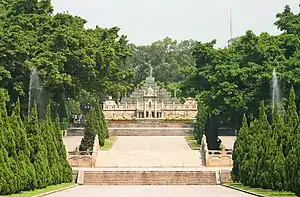| Second Guangzhou Uprising | |||||||
|---|---|---|---|---|---|---|---|
| Part of the Xinhai Revolution | |||||||
 Yellow Flower Mound Park and the Mausoleum of the 72 Martyrs | |||||||
| |||||||
| Belligerents | |||||||
|
|
| ||||||
| Commanders and leaders | |||||||
| Huang Xing | Zhang Jianbo | ||||||
| Strength | |||||||
| 120 | Thousands | ||||||
| Casualties and losses | |||||||
| 86 |
| ||||||
| Second Guangzhou Uprising | |||||||||||
|---|---|---|---|---|---|---|---|---|---|---|---|
 A memorial plaque in the park | |||||||||||
| Traditional Chinese | 辛亥廣州起義 | ||||||||||
| Simplified Chinese | 辛亥广州起义 | ||||||||||
| Literal meaning | Xinhai Guangzhou Uprising | ||||||||||
| |||||||||||
| Yellow Flower Mound Uprising | |||||||||||
| Traditional Chinese | 黃花崗起義 | ||||||||||
| Simplified Chinese | 黄花岗起义 | ||||||||||
| |||||||||||
| Yellow Flower Mound Revolt | |||||||||||
| Traditional Chinese | 黃花岡之役 | ||||||||||
| Simplified Chinese | 黃花岡之役 | ||||||||||
| |||||||||||
The Second Guangzhou (Canton) Uprising, known in Chinese as the Yellow Flower Mound Uprising or the Guangzhou Xinhai Uprising, was a failed uprising took place in China led by Huang Xing and his fellow revolutionaries against the Qing dynasty in Canton (Guangzhou). It is honored in Guangzhou's Yellow Flower Mound or Huanghuagang Park.
History

At this time Malaya, which included what is now Peninsular Malaysia and Singapore, had the largest Overseas Chinese population outside of China itself. Many of them were rich and carried out activities for the revolutionaries. On November 13, 1910, Sun Yat-sen, along with several leading figures of the Tongmenghui, gathered at the Penang conference to draw up plans for a decisive battle. The following day on November 14, 1910, Sun Yat-sen chaired an Emergency Meeting of the Tongmenghui at 120 Armenian Street (now the Sun Yat-sen Museum Penang) and raised Straits Dollars $8,000 on the spot. The planning events are known as the 1910 Penang Conference. [1] Originally planned to occur on April 13, 1911, the preparations on April 8 did not go as planned, delaying the date to April 27.[2]
Huang Xing and nearly a hundred fellow revolutionaries forced their way into the residence of the Qing Viceroy of Guangdong and Guangxi provinces. The uprising was initially successful but Qing reinforcements turned the battle into a catastrophic defeat. Most revolutionaries were killed, only few managed to escape. Huang Xing was wounded during the battle; he lost two of his fingers when his hand was hit by a bullet.[3] 86 bodies were found (but only 72 could be identified), and the bodies of yet many others were not found.[2][4] The dead were mostly nationalistic, revolutionary youths with all kinds of social backgrounds – former students, teachers, journalists, and patriotic overseas Chinese. Some of them were of high rank in the Alliance. Before the battle, most of the revolutionaries knew that the battle would probably be lost, since they were heavily outnumbered, but they went into battle anyway. The mission was carried out like that of a suicide squad.[2] Their letters to their loved ones were later found.
Legacy
The dead were buried together in one grave on the Yellow Flower Mound, a mound near where they fought and died which has lent its name to the uprising.[2] After the Chinese revolution, a cemetery was built on the mound with the names of those 72 revolutionary nationalists. They were commemorated as the "72 martyrs."[2] Some historians believe that the uprising was a direct cause of the Wuchang uprising, which eventually led to the Xinhai Revolution and the founding of the Republic of China. Among the martyrs who sacrificed themselves was revolutionary Lin Chueh-min.[5]
Memorials
The uprising is remembered annually in Taiwan on March 29, as Youth Day.[6]
 The Mausoleum of the 72 Martyrs, topped by the Statue of Liberty.
The Mausoleum of the 72 Martyrs, topped by the Statue of Liberty. Yellow Flower Mound Park.
Yellow Flower Mound Park.
In popular culture
The 1980 film Magnificent 72 and the 2011 film 72 Heroes focus on the uprising. Events of the uprising open the 2011 film 1911.
See also
References
- ↑ Khoo, Salma Nasution. (2008). Sun Yat-sen in Penang. Areca publishing. ISBN 978-983-42834-8-3. pp. 50, 62, 122.
- 1 2 3 4 5 王恆偉. (2005) (2006) 中國歷史講堂 #5 清. 中華書局. ISBN 962-8885-28-6. pp. 195–198.
- ↑ 余世存. 名人传记:黄兴家族百年沧桑 (in Chinese). pp. 4–10.
- ↑ "中國窗-香港商報電子報". Cnwnc.com. Retrieved 2011-10-12.
- ↑ Langmead, Donald. (2011). Maya Lin: A Biography. ABC-CLIO publishing. ISBN 978-0-313-37853-9. pp. 5–6.
- ↑ "Youth Day". Government Information Office, ROC. Archived from the original on 31 March 2012. Retrieved 11 March 2012.